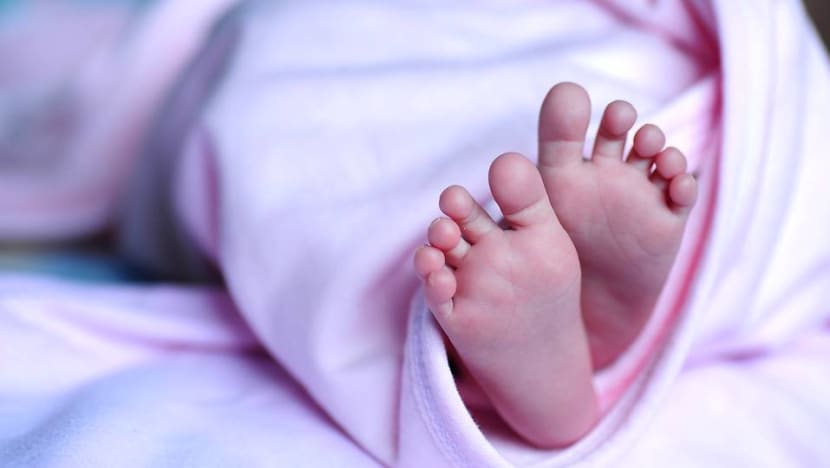4-month-old baby suffocated to death co-sleeping with mother, coroner reiterates safe sleeping habits
The mother woke up and realised that the baby was no longer on the mattress. Instead, her legs were sticking out from a gap between the bed and the wall.

SINGAPORE: A four-month-old baby who was regularly put to bed for the night on a full-size bed died of asphyxiation after falling into a gap.
The State Coroner ruled the girl's death a misadventure and reiterated safe sleeping practices, which include placing the baby to sleep alone in its crib, cot or bassinet.
In findings released this week, State Coroner Adam Nakhoda said he "strongly" recommended that parents of infants adhere to safe sleep practices, which would greatly reduce the incidence of infants dying from positional asphyxia.
Positional asphyxia occurs when a person cannot breathe because they are in a position that causes their airway to be blocked.
The court heard that the baby lived with her parents, grandfather and a tenant. The parents' names were redacted from court documents.
Around the time of her death, the baby was learning how to flip, but was largely unsuccessful. She also could not flip continuously nor hold up her head, her parents said.
In December 2021, the baby had a low-grade fever for a few days after her pneumococcal vaccination.
The infant was more tired and less active and had some "noisy breathing", but her mother did not take her to see a doctor for these symptoms.
BABY'S USUAL SLEEPING POSITION
The baby usually slept on a mattress that was placed on top of her parents' queen-size bed.
The bed was cornered by walls on the head and left side. At the corner where the two walls met, there was a gap in the left-hand wall that created a recess between the left side of the bed and that wall.
The recess was about 22cm wide and 25cm deep. The baby slept on a mattress beside the recess until she was about two months old, when her mother repositioned the baby's mattress to avoid the baby falling into the gap.
There was also a pillow on the floor below the recess, placed as a precaution in case the baby fell.
On Dec 19, 2021, the mother spoke to the father, who was at work, via video call at about 8pm. The video call was left on during the rest of that night, into the early morning of the next day.
At about 2am or 3am on Dec 20, 2021, the baby's father looked at the images on the video call and saw that his daughter was on her mattress, swaddled in a white cloth and facing upwards.
He fell asleep at his workplace at about 4am. About an hour later, the baby cried and woke her mother, who fed her milk.
The woman then left the baby with the bottle to feed herself and went back to sleep.
When the baby's mother next woke at 6am, she realised that her daughter was not on her mattress on the bed.
MOTHER DISCOVERS BABY FELL INTO RECESS
She saw her baby's legs pointing upwards from the recess. When she looked in, she saw her child's face angled towards the bed, with her legs leaning towards the side of the bed.
The mother immediately lifted the baby out, but she was unresponsive and her eyes were closed. The woman shouted for help and began crying, and her tenant went in and saw that the baby was not moving.
There was dried milk coming out of the child's nose. The mother told the tenant that she had not realised the baby had fallen into the recess.
The tenant took the baby and realised that she was already cold. He thought the baby might be choking and tried to dislodge any obstruction by hitting her back.
He carried out cardiopulmonary resuscitation while waiting for paramedics to arrive.
The baby was taken to hospital but did not revive. She was pronounced dead that same morning.
An autopsy found that the cause of death was positional asphyxia and not due to a natural disease process.
A report by the forensic pathologists on the case stated that there was an increased risk of overlaying with co-sleeping - when the sleeping parent turns over and lays over the infant. There was also risk of suffocation from pillows and blankets meant for adults.
EXPERT ON SAFE SLEEP
At the request of the court, Dr Nirmal Kavalloor Visruthan, senior consultant of neonatology at KK Women's and Children's Hospital, provided an expert report on the proper positioning of an infant during sleep.
He said parents should avoid allowing infants under 12 months to sleep in a prone position, or face down. Sleeping in a supine position, or on the back, was safest for both night sleeps and naps.
Dr Nirmal said that babies who are used to sleeping on their backs for night sleeps but then are put in a prone position for naps have an even greater risk of Sudden Infant Death Syndrome.
He said there were no scientific publications that support the claim that sleeping face down was safe for infants with medical issues like reflux.
He added that secretions and milk were better removed if a baby is lying supine, as the baby's oesophagus is behind the trachea.
Secretions and milk that are spat up could then, by gravity, flow back to the oesophagus to be swallowed rather than flow down the trachea or airway.
Dr Nirmal said it was safer for an infant to sleep in a separate cot in the same room as the parents for the first year of life or for at least six months.
Infants could be brought to the main bed for breastfeeding and activity or play, but should be placed back in the cot for naps and sleep.
They should be placed on a firm, flat and non-inclined sleep surface, preferably in a safety-approved crib with a tight-fitting mattress, covered with a fitted sheet with no other bedding or soft objects.
A firm surface would maintain its shape and not indent or conform to the shape of the infant's head.
Dr Nirmal said parents should ensure that there are no gaps between the mattress and the wall of the sleeping area. Couches and armchairs are extremely dangerous places for an infant and should never be used for infant sleep, he said.
He stressed that toys, loose bedding, blankets, pillows, bumpers and mobiles should be kept away from the infant's cot as these pose a risk of smothering.
Dr Nirmal said that some infants could turn over by the age of four months, including turning from their backs to their fronts, even if swaddled.
SHOULD NOT BE SWADDLED IF THEY'RE LEARNING TO FLIP
He said the American Academy of Paediatrics recommended that babies should not be swaddled once they learn to flip, as it would be more difficult for the baby to flip back if swaddled.
Having an infant sleep on an adult mattress that bordered a wall was a hazard, said Dr Nirmal. If the baby flips towards the wall while sleeping, its nose and mouth could be wedged against the wall and mattress.
He said the hospitals' messaging on proper positioning of an infant during sleep and the ABCs of safe sleep are made known to parents during antenatal visits, where they are given a checklist of things to buy in preparation for the birth.
Parents are also given a discharge health booklet and advice including safe sleeping guidelines.
Dr Nirmal also said it was not ideal for a four-month-old infant to feed itself, because there was always a risk of choking. He said infants should be fed by their parents until they are at least six months old.
The coroner said losing a child is always a devastating event. He said it was not clear whether the baby was placed on her own infant mattress or directly on the main bed's mattress, but it was unsafe regardless for the baby to sleep on the bed rather than in her own cot.
There were several hazards including the recess near the head of the bed that was large enough for the baby to fall into.
Even if the baby had fallen into the recess and ended up face down, she could have asphyxiated from being buried in the pillow placed on the floor to catch her fall.
If she had been put to sleep below the recess, there was also the risk she could turn and get her face wedged between the bed's mattress and the wall.
The coroner said that when the baby fell into the recess, she was in a head-down position and incapable of extricating herself.
As she was in this position for an extended period of time, she could not breathe normally, resulting in hypoxia and death.
The coroner found that the baby was likely beyond saving by the time she was found.
He gave his condolences to the baby's parents on the tragic loss of their daughter.














